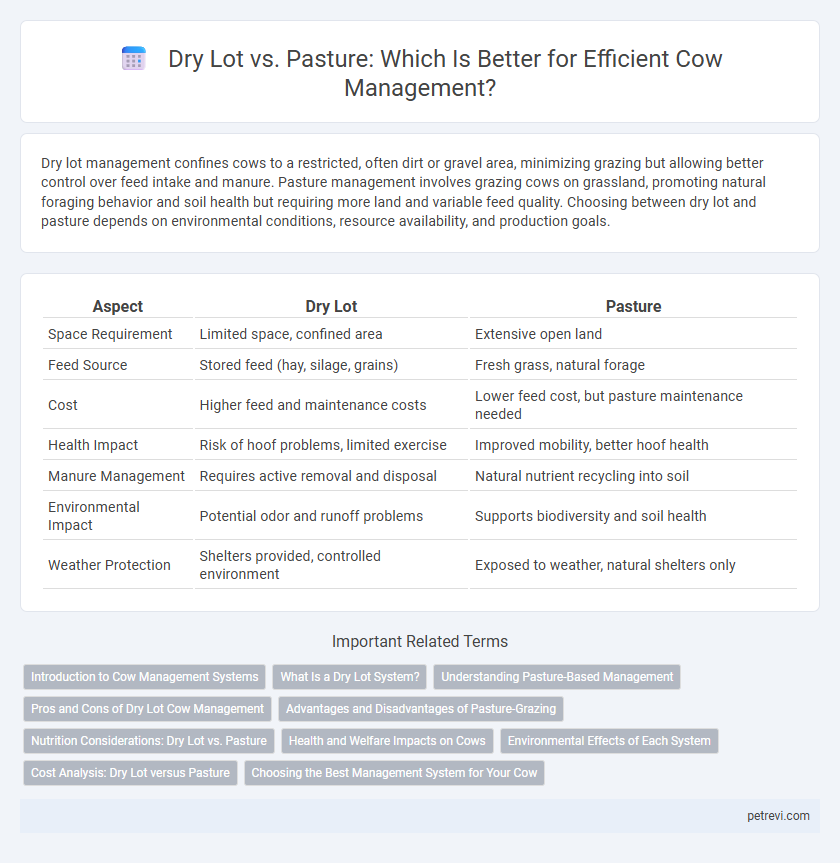Dry lot management confines cows to a restricted, often dirt or gravel area, minimizing grazing but allowing better control over feed intake and manure. Pasture management involves grazing cows on grassland, promoting natural foraging behavior and soil health but requiring more land and variable feed quality. Choosing between dry lot and pasture depends on environmental conditions, resource availability, and production goals.
Table of Comparison
| Aspect | Dry Lot | Pasture |
|---|---|---|
| Space Requirement | Limited space, confined area | Extensive open land |
| Feed Source | Stored feed (hay, silage, grains) | Fresh grass, natural forage |
| Cost | Higher feed and maintenance costs | Lower feed cost, but pasture maintenance needed |
| Health Impact | Risk of hoof problems, limited exercise | Improved mobility, better hoof health |
| Manure Management | Requires active removal and disposal | Natural nutrient recycling into soil |
| Environmental Impact | Potential odor and runoff problems | Supports biodiversity and soil health |
| Weather Protection | Shelters provided, controlled environment | Exposed to weather, natural shelters only |
Introduction to Cow Management Systems
Dry lot systems offer controlled environments with easy manure management and reduced parasite exposure, optimizing cow health and productivity. Pasture-based systems provide natural grazing that enhances animal welfare and lowers feed costs by utilizing available forage resources. Selecting between dry lot and pasture management depends on factors such as climate, land availability, and production goals for sustainable cow farming.
What Is a Dry Lot System?
A dry lot system in cow management is a confined area where cattle are kept without access to pasture forage, often used to control feeding and reduce soil erosion. This system allows precise nutritional management and can improve manure collection efficiency, enhancing overall herd health. Dry lots require proper waste handling and regular maintenance to prevent environmental issues and maintain animal welfare.
Understanding Pasture-Based Management
Pasture-based management allows cows to graze on natural grasses, promoting better animal welfare and nutrient intake compared to dry lot systems. This approach enhances soil health through natural fertilization and improves biodiversity by maintaining diverse plant species. Effective rotational grazing within pasture systems optimizes forage utilization and supports sustainable livestock production.
Pros and Cons of Dry Lot Cow Management
Dry lot cow management offers precise feed control and minimizes pasture degradation, reducing soil erosion and weed growth. It allows for better monitoring of cow health and easier manure management, decreasing environmental impact. However, dry lots can lead to higher costs for feed and bedding, and they may increase the risk of respiratory diseases due to limited ventilation and space.
Advantages and Disadvantages of Pasture-Grazing
Pasture grazing offers cows natural forage that enhances nutrient intake and promotes healthier digestion through varied plant species. However, it poses challenges such as fluctuating pasture quality, potential parasite exposure, and seasonal limitations affecting feed availability. Effective pasture management requires balancing these factors to optimize cow health and productivity.
Nutrition Considerations: Dry Lot vs. Pasture
Dry lot systems offer precise diet formulation through controlled feed rations, optimizing nutrient intake and minimizing variability compared to pasture grazing. Pasture provides natural forage rich in fiber and diverse nutrients but often results in inconsistent nutrient supply due to seasonal and environmental factors. Efficient cow management requires balancing energy, protein, and mineral availability, with dry lots ensuring consistency while pastures contribute beneficial grazing behavior and rumen health.
Health and Welfare Impacts on Cows
Dry lot systems provide controlled environments that reduce parasite exposure and hoof problems in cows, enhancing overall health and preventing mud-related injuries. Pasture-based management offers cows natural foraging, promoting digestive health and allowing expression of natural behaviors, which supports improved welfare. Balancing nutrition and environmental exposure in each system is critical to minimizing stress and disease risks, ensuring optimal cow health and welfare outcomes.
Environmental Effects of Each System
Dry lot systems concentrate cattle in confined spaces, leading to increased manure accumulation that can cause nutrient runoff and water contamination if not properly managed. Pasture-based management allows natural vegetation to absorb nutrients, promoting soil health and carbon sequestration, which helps mitigate greenhouse gas emissions. However, overgrazing in pastures may result in soil erosion and reduced plant biodiversity, impacting long-term ecosystem stability.
Cost Analysis: Dry Lot versus Pasture
Dry lot systems often incur higher upfront costs due to infrastructure like feed troughs and manure management, but they reduce land expenses and allow precise feed control, resulting in predictable operational costs. Pasture-based management has lower initial investment and provides natural forage, lowering feed expenses, though variable forage availability can lead to inconsistent nutritional intake and fluctuating management costs. Comparing cost efficiency depends on regional forage quality, land prices, and labor availability, with dry lots favored in high land-cost areas and pastures preferred where land is inexpensive and forage growth is reliable.
Choosing the Best Management System for Your Cow
Choosing between dry lot and pasture management for cows depends on factors such as climate, land availability, and nutritional needs. Dry lot systems offer controlled feeding, reduce parasite exposure, and can improve manure management, while pastures provide natural grazing, promote animal welfare, and enhance soil health. Evaluating the specific requirements of your herd and farm resources ensures optimal cow performance and sustainability.
Dry Lot vs Pasture for Cow Management Infographic

 petrevi.com
petrevi.com